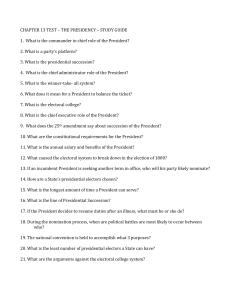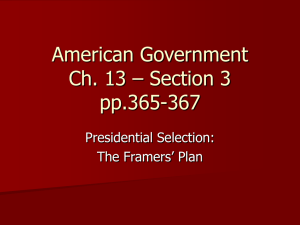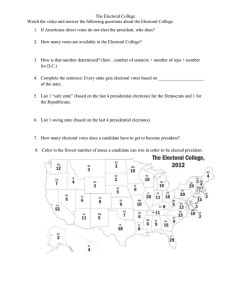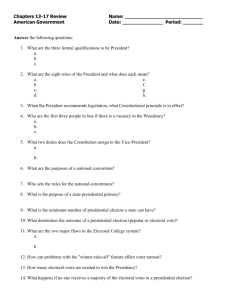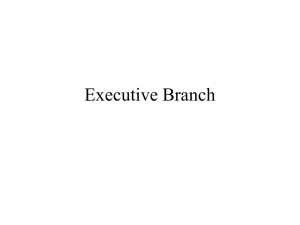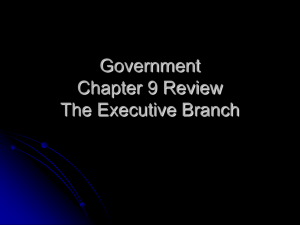Presidential Succession AND THE VICE PRESIDENT
advertisement
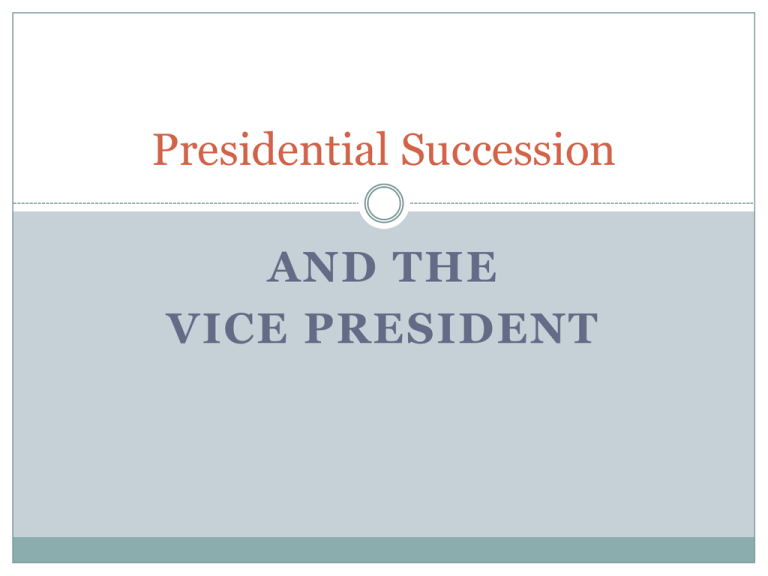
Presidential Succession AND THE VICE PRESIDENT Presidential Succession Act of 1947 Established that following the Vice President, it would be the Speaker of the House and then the President pro tempore. 25th Amendment 1967 1. In the case of removal or death of the President, the Vice President becomes President 2. If there is a vacancy in the office of Vice President, the President nominate a VP with a majority vote in both Houses. 3. If the President informs the Speaker of the House and the President pro tempore that he is unable to perform the duties as president, then power goes to the Vice President. 4. If the VP and a majority of cabinet members determine that the President is unable to do his job and inform the Speaker and President pro tempore, then the VP shall take over. The man who could be President Vice President - Duties Formal Duties 1. To preside over the Senate 2. Help the decide the question of Presidential disability Informal duties “Balance the ticket” Oh, and the Vice President cannot be fired…by the President How we pick our President - Basics It is a process, not a place. Electoral College In the presidential election, you do not cast your vote for the candidate, instead you vote to elect presidential electors. The Electoral College - Basics How many electoral votes are there? 538 How many does one need to win? 270 How is the number of electoral votes determined? # of Representatives + 2 Senators (every state has at least 3) How many states have a winner – take-all system? 48 **Maine and Nebraska use a proportional type vote When do electors cast their votes? December 6th Is it possible to win the popular vote, but lose the electoral vote? YES 23rd Amendment gives DC three electors and treats it like a state fore the purpose of the electoral college. If No Candidate Gets 270??? What happens when there is a tie? House of Representative elects the President and the Senate elects the VP *If the HOR can’t decide on a President by the 20th of January the newly elected Vice President shall act as President until a choice is made. *If there isn’t a majority of votes for the Vice President, the Senate decides between the two top candidates. The Meeting 1. After the election the electors meet the first Monday after the first Wednesday after the election. 2. Electors meet in their state, where they cast their votes for President and Vice President, on separate ballots. 3. The party that wins the state in the general election selects the members from that state.1. The Final Decision *On January 6th each states electoral votes are counted in a joint session of Congress. *Vice President as the President of the Senate presides over the count and announces the results. *The President is sworn in on January 20th. The Trouble with the Electoral College 1. The winner-take-all feature- The winning candidate receives all of the electoral votes for the state that win. 2. The popular vote winner doesn’t always win the Electoral college. This has happened four times. 3. By law do electoral have to vote the way the state “tells” them to? NO **They are called “faithless electors” It would take an amendment to change the Electoral College process. April 5, 2016 1. Warm Up 2.Notes over the Presidency 3.Test April 7th 4.Study Guide due April 7th Students will understand the powers of the President and how we elect the President. 1. The _______ Amendment states that if there is a vacancy in the office of VP the President can appoint a new VP. 2. If something happens to the President, who is the last person to take the office of President? 3. As ____________ the President is “the representative of all the people.” 4. As ____________ the President is the head of the nation’s armed forces. Presidential Power LINE-ITEM VETO EXECUTIVE PRIVILEGE WAR POWERS EXECUTIVE ORDER PARDON Line-Item Veto THE PRESIDENT COULD VETO A LINE OF A BILL NOW UNCONSTITUTIONAL TOO MUCH POWER FOR THE PRESIDENT Executive Privilege THE CONSTITUTIONAL PRINCIPLE THAT PERMITS THE PRESIDENT AND HIGH LEVEL EXECUTIVE BRANCH OFFICERS TO WITHHOLD INFORMATION FROM CONGRESS, THE COURTS, AND ULTIMATELY THE PUBLIC. THIS PRESIDENTIAL POWER IS CONTROVERSIAL BECAUSE IT IS NOWHERE MENTIONED IN THE U.S. CONSTITUTION War Powers 1. COMMANDER IN CHIEF 2. HAS THE FINAL AUTHORITY OVER AND RESPONSIBILITY FOR ALL MILITARY MATTERS 3. CAN MAKE UNDECLARED WAR 4. POWER IS ALL MOST WITHOUT LIMIT War Powers Resolution 1. MUST NOTIFY CONGRESS WITHIN 48 HOURS AFTER SENDING AMERICAN FORCES 2. COMBAT MUST END WITHIN 60 DAYS, UNLESS CONGRESS AGREES TO ALLOW LONGER 3. CONGRESS MAY END THE COMBAT COMMITMENT AT ANY TIME Executive Order DIRECTIVE, RULE, OR REGULATION ISSUED BY THE PRESIDENT HAVING THE FORCE OF LAW The Growth of Presidential Power THE PRESIDENT IS THE SINGLE, COMMANDING HEAD OF THE EXECUTIVE BRANCH 2. PEOPLE HAVE DEMANDED THAT THE FEDERAL GOVERNMENT PLAY A LARGER ROLE AND HAVE LOOKED TO THE PRESIDENT FOR LEADERSHIP 1. 3. THE NEED FOR QUICK DECISIONS IN THE TIME OF NATIONAL EMERGENCIES 4. CONGRESS HAD DELEGATED MORE POWER TO THE EXECUTIVE BRANCH TO CARRY OUT ITS LAWS 5. THE PRESIDENT HAS A UNIQUE ABILITY TO ATTRACT PUBLIC ATTENTION AND BUILD SUPPORT FOR POLICIES AND ACTIONS.


